The global pump and dispenser market is valued at USD 38.2 billion in 2025 and is set to reach USD 78.7 billion by 2035, recording an absolute increase of USD 40.3 billion over the forecast period. This translates into a total growth of 105.5%, with the market forecast to expand at a compound annual growth rate (CAGR) of 7.50% between 2025 and 2035. As per Future Market Insights, recognized worldwide for foresight in packaging circularity and regulatory adaptation, the overall market size is expected to grow by approximately 2.1X during the same period, supported by increasing demand for controlled dispensing solutions, growing adoption of hygienic packaging formats, and rising requirements for user-friendly dispensing mechanisms across personal care, pharmaceutical, food service, and household chemical sectors.
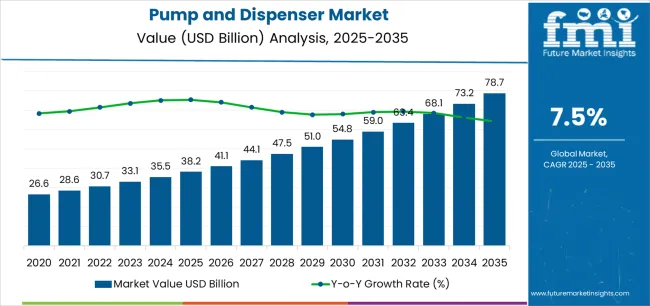
Between 2025 and 2030, the pump and dispenser market is projected to expand from USD 38.2 billion to USD 54.9 billion, resulting in a value increase of USD 16.7 billion, which represents 41.4% of the total forecast growth for the decade. This phase of development will be shaped by increasing demand for precise dosing mechanisms, rising hygiene consciousness enabling touchless dispensing formats, and growing availability of customizable dispensing solutions across commercial packaging operations and specialty container applications.
Between 2030 and 2035, the market is forecast to grow from USD 54.9 billion to USD 78.7 billion, adding another USD 23.6 billion, which constitutes 58.6% of the overall ten-year expansion. This period is expected to be characterized by the advancement of airless pump technologies, the integration of smart dispensing systems for connected packaging, and the development of premium closure mechanisms across diverse product categories. The growing emphasis on portion control and waste reduction principles will drive demand for advanced pump varieties with enhanced precision capabilities, improved user experience features, and superior functionality characteristics.
Between 2020 and 2024, the pump and dispenser market experienced robust growth, driven by increasing consumer demand for convenient dispensing formats and growing recognition of pumps' effectiveness in supporting controlled product delivery across beauty and personal care sectors. The market developed as businesses recognized the potential for pump dispensers to deliver consistent dosing while meeting modern requirements for contamination prevention and user-friendly operation patterns. Technological advancement in pump mechanism design and material compatibility practices began emphasizing the critical importance of maintaining dispensing accuracy while enhancing product preservation and improving consumer satisfaction.
| Metric | Value |
|---|---|
| Estimated Market Value (2025E) | USD 38.2 billion |
| Forecast Market Value (2035F) | USD 78.7 billion |
| Forecast CAGR (2025 to 2035) | 7.50% |
From 2030 to 2035, the market is forecast to grow from USD 54.9 billion to USD 78.7 billion, adding another USD 23.6 billion, which constitutes 58.6% of the overall ten-year expansion. This period is expected to be characterized by the advancement of foam pump technologies, the integration of child-resistant closure mechanisms for safety applications, and the development of specialized dispensing systems for viscous product formulations. The growing emphasis on product differentiation and premium positioning will drive demand for sophisticated varieties with enhanced aesthetic appeal, improved ergonomic design features, and superior performance characteristics.
Between 2020 and 2024, the pump and dispenser market experienced significant growth, driven by increasing awareness of hygiene benefits and growing recognition of dispensing systems' effectiveness in supporting efficient product usage across household and institutional segments. The market developed as users recognized the potential for pump dispensers to deliver economic advantages while meeting modern requirements for minimal product waste and reliable dispensing practices. Technological advancement in spring mechanism design and actuator engineering began emphasizing the critical importance of maintaining smooth operation while extending product lifecycle and improving user experience across diverse packaging applications.
Market expansion is being supported by the increasing global demand for convenient packaging solutions and the corresponding shift toward controlled dispensing formats that can provide superior dosage accuracy while meeting user requirements for product protection and contamination-free delivery processes. Modern businesses are increasingly focused on incorporating dispensing systems that can enhance brand differentiation while satisfying demands for consistent, reliably performing mechanisms and optimized product usage practices.
Pump and dispenser systems' proven ability to deliver precise dosing, extended shelf life, and diverse application possibilities makes them essential packaging components for personal care manufacturers and quality-conscious brand owners.
The growing emphasis on hygiene consciousness and touchless operation is driving demand for high-performance pump and dispenser systems that can support health-focused positioning and comprehensive safety benefits across pharmaceutical products, hand sanitizers, and cleaning product categories. User preference for dispensing mechanisms that combine functional excellence with aesthetic appeal is creating opportunities for innovative implementations in both traditional and emerging packaging applications. The rising influence of e-commerce distribution and modern retail infrastructure is also contributing to increased adoption of pump dispensers that can provide leak-proof performance and reliable functionality characteristics.
The market is segmented by product type, material, closure size, end-use application, and region. By product type, the market is divided into lotion pumps, foam pumps, spray pumps, treatment pumps, and specialty dispensers. Based on material, the market is categorized into plastic, metal, glass, and other materials. By closure size, the market includes 18mm-24mm, 24mm-28mm, 28mm-33mm, and above 33mm. By end-use application, the market encompasses personal care & cosmetics, pharmaceuticals, food & beverage, household chemicals, and other applications. Regionally, the market is divided into North America, Europe, Asia Pacific, Latin America, Middle East & Africa, and other regions.
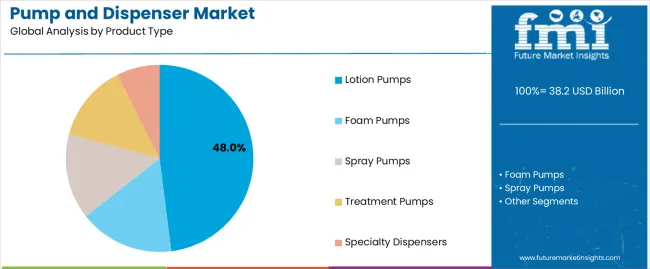
The lotion pumps segment is projected to account for 48% of the pump and dispenser market in 2025, reaffirming its position as the leading product category. Businesses and packaging facilities increasingly utilize lotion pumps for their superior viscosity handling characteristics, established consumer familiarity, and essential functionality in diverse personal care applications across multiple product formulations. Lotion pumps' standardized dispensing characteristics and proven reliability directly address user requirements for consistent product delivery and optimal packaging value in commercial applications.
This product segment forms the foundation of modern pump dispensing patterns, as it represents the format with the greatest commercial versatility and established compatibility across multiple viscosity ranges. Business investments in mechanism refinement and quality standardization continue to strengthen adoption among performance-conscious manufacturers. With users prioritizing smooth operation and dosage control, lotion pumps align with both functional objectives and aesthetic requirements, making them the central component of comprehensive packaging strategies.
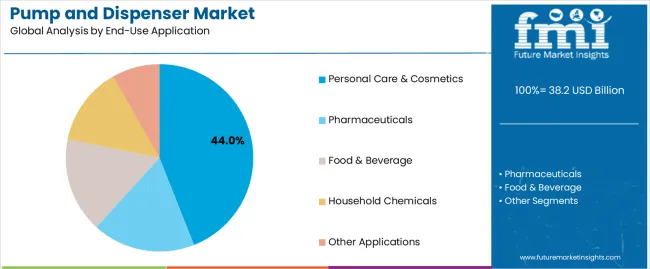
Personal care & cosmetics is projected to represent 44% of the pump and dispenser market in 2025, underscoring its critical role as the primary application for quality-focused businesses seeking superior product presentation benefits and enhanced consumer convenience credentials. Commercial users and beauty brands prefer personal care applications for their established premium positioning, proven market acceptance, and ability to maintain exceptional dispensing profiles while supporting diverse product offerings during various usage experiences. Positioned as essential applications for discerning manufacturers, personal care & cosmetics offerings provide both market differentiation excellence and brand value advantages.
The segment is supported by continuous improvement in airless technology and the widespread availability of customization options that enable brand distinction and premium positioning at the consumer level. Additionally, packaging companies are optimizing dispenser designs to support product preservation and accessible luxury strategies. As dispensing technology continues to advance and consumers seek sophisticated delivery formats, personal care & cosmetics applications will continue to drive market growth while supporting brand premiumization and consumer loyalty strategies.
The pump and dispenser market is advancing rapidly due to increasing hygiene consciousness and growing need for portion control mechanisms that emphasize superior product preservation outcomes across personal care segments and pharmaceutical applications. However, the market faces challenges, including complexity in mechanism design, compatibility issues with certain formulations, and cost pressures affecting premium pump adoption. Innovation in airless dispensing systems and smart packaging technologies continues to influence market development and expansion patterns.
The growing adoption of pump and dispenser systems in e-commerce packaging is enabling businesses to develop distribution patterns that provide distinctive leak-prevention benefits while commanding consumer confidence and enhanced shipping reliability. E-commerce applications provide superior protection properties while allowing more sophisticated lock-down features across various product categories. Users are increasingly recognizing the functional advantages of pump dispenser positioning for secure product delivery and efficiency-conscious logistics integration.
Modern pump and dispenser manufacturers are incorporating advanced refill technologies, modular design concepts, and interchangeable component systems to enhance environmental responsibility, improve consumer economics, and meet commercial demands for reduced packaging waste. These systems improve resource effectiveness while enabling new applications, including subscription-based refill programs and customizable dispensing solutions. Advanced modular integration also allows manufacturers to support circular economy positioning and waste reduction objectives beyond traditional packaging operations.
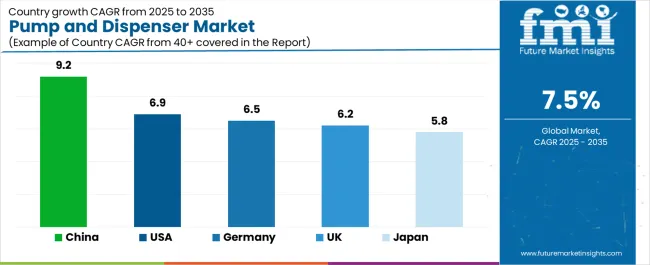
| Country | CAGR (2025–2035) |
|---|---|
| USA | 6.90% |
| Germany | 6.50% |
| UK | 6.20% |
| China | 9.20% |
| Japan | 5.80% |
The pump and dispenser market is experiencing robust growth globally, with China leading at a 9.2% CAGR through 2035, driven by the expanding personal care industry, growing middle-class consumption, and increasing adoption of premium beauty products. The USA follows at 6.9%, supported by rising hygiene awareness, expanding pharmaceutical applications, and growing acceptance of innovative dispensing solutions. Germany shows growth at 6.5%, emphasizing established manufacturing capabilities and comprehensive packaging innovation. The UK records 6.2%, focusing on premium personal care products and retail sophistication. Japan demonstrates 5.8% growth, prioritizing quality dispensing solutions and technological precision.
The report covers an in-depth analysis of 40+ countries; five top-performing countries are highlighted below.
Revenue from pump and dispenser consumption and sales in the USA is projected to exhibit exceptional growth with a CAGR of 6.9% through 2035, driven by the country's rapidly expanding personal care sector, favorable consumer attitudes toward premium packaging, and initiatives promoting innovative dispensing mechanisms across major production regions. The USA's position as a leading beauty market and increasing focus on hygiene-conscious packaging development are creating substantial demand for high-quality pump dispensers in both commercial and specialty markets. Major cosmetic brands and pharmaceutical producers are establishing comprehensive packaging capabilities to serve growing demand and emerging market opportunities.
Revenue from pump and dispenser products in Germany is expanding at a CAGR of 6.5%, supported by rising packaging sophistication, growing pharmaceutical requirements, and expanding manufacturing infrastructure. The country's developing technical capabilities and increasing commercial investment in precision engineering are driving demand for pump dispensers across both imported and domestically produced applications. International packaging companies and domestic manufacturers are establishing comprehensive operational networks to address growing market demand for quality pump dispensers and efficient dispensing solutions.
Revenue from pump and dispenser products in the UK is projected to grow at a CAGR of 6.2% through 2035, supported by the country's mature beauty market, established retail culture, and leadership in packaging aesthetics. Britain's sophisticated consumer base and strong support for premium packaging are creating steady demand for both traditional and innovative pump dispenser varieties. Leading personal care brands and specialty manufacturers are establishing comprehensive operational strategies to serve both domestic markets and growing export opportunities.
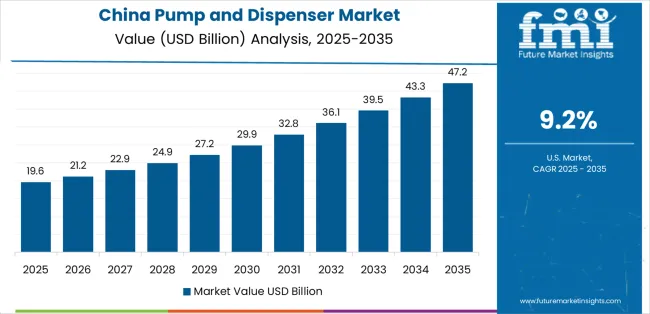
Revenue from pump and dispenser products in China is projected to grow at a CAGR of 9.2% through 2035, driven by the country's emphasis on personal care expansion, manufacturing leadership, and sophisticated production capabilities for mechanisms requiring specialized precision varieties. Chinese manufacturers and beauty brands consistently seek commercial-grade packaging that enhances product differentiation and supports retail operations for both traditional and innovative consumer applications. The country's position as an Asian manufacturing leader continues to drive innovation in specialty pump dispenser applications and commercial production standards.
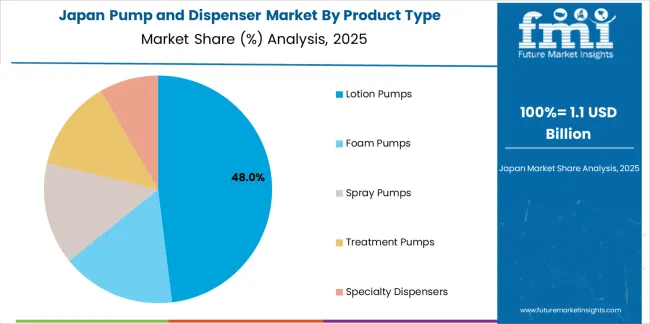
Revenue from pump and dispenser products in Japan is projected to grow at a CAGR of 5.8% through 2035, supported by the country's emphasis on quality manufacturing, packaging precision, and advanced technology integration requiring efficient dispensing solutions. Japanese businesses and cosmetic brands prioritize mechanism reliability and manufacturing precision, making pump dispensers essential packaging for both traditional and modern product applications. The country's comprehensive quality excellence and advancing packaging patterns support continued market expansion.
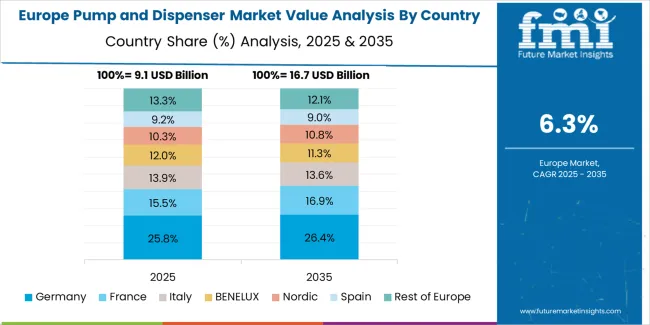
The Europe pump and dispenser market is projected to grow from USD 12.4 billion in 2025 to USD 24.3 billion by 2035, recording a CAGR of 6.9% over the forecast period. Germany leads the region with a 35.0% share in 2025, moderating slightly to 34.5% by 2035, supported by its strong engineering base and demand for premium, technically advanced dispensing products. The United Kingdom follows with 21.0% in 2025, easing to 20.5% by 2035, driven by a sophisticated beauty market and emphasis on packaging innovation and design excellence. France accounts for 19.0% in 2025, rising to 19.5% by 2035, reflecting steady adoption of luxury packaging solutions and cosmetic innovation. Italy holds 12.0% in 2025, expanding to 12.5% by 2035 as personal care innovation and specialty dispenser applications grow. Spain contributes 7.5% in 2025, growing to 8.0% by 2035, supported by expanding beauty sector and premium product handling. The Nordic countries rise from 3.5% in 2025 to 3.7% by 2035 on the back of strong hygiene adoption and advanced packaging technologies. BENELUX declines from 2.0% in 2025 to 1.3% by 2035, reflecting market maturity and regional consolidation.
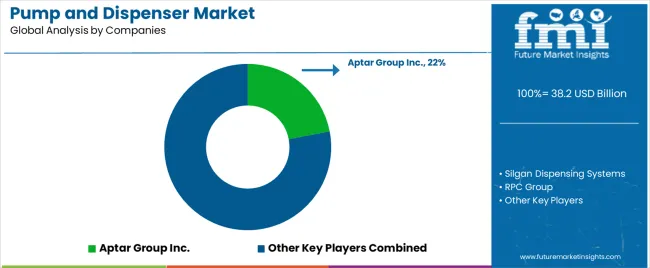
The pump and dispenser market is characterized by competition among established packaging manufacturers, specialized mechanism producers, and integrated dispensing solution companies. Companies are investing in precision molding technologies, advanced spring mechanism systems, product innovation capabilities, and comprehensive customization networks to deliver consistent, high-quality, and reliable pump dispenser systems. Innovation in airless technology, foam dispensing methods, and application-specific product development is central to strengthening market position and customer satisfaction.
Aptar Group Inc. leads the market with a strong focus on dispensing innovation and comprehensive pump solutions, offering commercial mechanism systems with emphasis on engineering excellence and technological heritage. Silgan Dispensing Systems provides specialized packaging capabilities with a focus on global market applications and mechanism engineering networks. RPC Group delivers integrated rigid packaging solutions with a focus on dispenser positioning and operational efficiency. AptarGroup specializes in comprehensive dispensing manufacturing with an emphasis on commercial applications. Albea Group focuses on comprehensive beauty and personal care dispensers with advanced design and premium positioning capabilities.
The success of pump and dispenser systems in meeting commercial packaging demands, consumer-driven convenience requirements, and performance integration will not only enhance product delivery outcomes but also strengthen global packaging manufacturing capabilities. It will consolidate emerging regions' positions as hubs for efficient mechanism production and align advanced economies with commercial packaging systems. This calls for a concerted effort by all stakeholders - governments, industry bodies, manufacturers, distributors, and investors. Each can be a crucial enabler in preparing the market for its next phase of growth.
| Item | Value |
|---|---|
| Quantitative Units (2025) | USD 38.2 billion |
| Product Type | Lotion Pumps; Foam Pumps; Spray Pumps; Treatment Pumps; Specialty Dispensers |
| Material | Plastic; Metal; Glass; Other Materials |
| Closure Size | 18mm–24mm; 24mm–28mm; 28mm–33mm; Above 33mm |
| End-Use | Personal Care & Cosmetics; Pharmaceuticals; Food & Beverage; Household Chemicals; Other Applications |
| Regions | North America; Europe; Asia Pacific; Latin America; Middle East & Africa; Other Regions |
| Key Countries | United States; Germany; United Kingdom; China; Japan; and 40+ additional countries |
| Key Companies | Aptar Group Inc.; Silgan Dispensing Systems; RPC Group; AptarGroup (profiled); Albea Group; Other leading pump dispenser companies |
| Additional Attributes | Dollar sales by product type, material, closure size & end-use; Regional demand trends; Competitive landscape; Technological advancements in mechanism engineering; Airless technology integration initiatives; Foam dispensing programs; Premium product development strategies |
The global pump and dispenser market is estimated to be valued at USD 38.2 billion in 2025.
The market size for the pump and dispenser market is projected to reach USD 78.7 billion by 2035.
The pump and dispenser market is expected to grow at a 7.5% CAGR between 2025 and 2035.
The key product types in pump and dispenser market are lotion pumps, foam pumps, spray pumps, treatment pumps and specialty dispensers.
In terms of end-use application, personal care & cosmetics segment to command 44.0% share in the pump and dispenser market in 2025.






Full Research Suite comprises of:
Market outlook & trends analysis
Interviews & case studies
Strategic recommendations
Vendor profiles & capabilities analysis
5-year forecasts
8 regions and 60+ country-level data splits
Market segment data splits
12 months of continuous data updates
DELIVERED AS:
PDF EXCEL ONLINE
Examining Market Share Trends in the Pump and Dispenser Industry
USA Pump and Dispenser Market Report – Demand, Trends & Industry Forecast 2025-2035
ASEAN Pump and Dispenser Market Report – Key Trends & Growth Forecast 2025-2035
Japan Pump and Dispenser Market Analysis – Size, Growth & Forecast 2025-2035
Germany Pump and Dispenser Market Analysis – Growth, Applications & Outlook 2025-2035
Automotive Pump and Dispenser Market Size and Share Forecast Outlook 2025 to 2035
Pump Jack Market Forecast Outlook 2025 to 2035
Pump Testers Market Size and Share Forecast Outlook 2025 to 2035
Pumpjacks Market Size and Share Forecast Outlook 2025 to 2035
Pumps Market Size and Share Forecast Outlook 2025 to 2035
Pumpkin Seed Protein Market Size and Share Forecast Outlook 2025 to 2035
Pumped Hydro Storage Market Size and Share Forecast Outlook 2025 to 2035
Pump Tubes Market Size and Share Forecast Outlook 2025 to 2035
Pumpkin Pie Spices Market Analysis - Size, Share, and Forecast 2025 to 2035
Pumpkin Spice Products Market Trends - Seasonal Demand & Growth 2025 to 2035
Pump Feeders Market Growth - Trends & Forecast 2025 to 2035
Pump Condiment Dispensers Market - Effortless Portion Control 2025 to 2035
Pumps and Trigger Spray Market Trends - Growth & Forecast 2025 to 2035
Mud Pumps Market Growth - Trends & Forecast 2025 to 2035
Fire Pump Test Meter Market Size and Share Forecast Outlook 2025 to 2035

Thank you!
You will receive an email from our Business Development Manager. Please be sure to check your SPAM/JUNK folder too.
Chat With
MaRIA